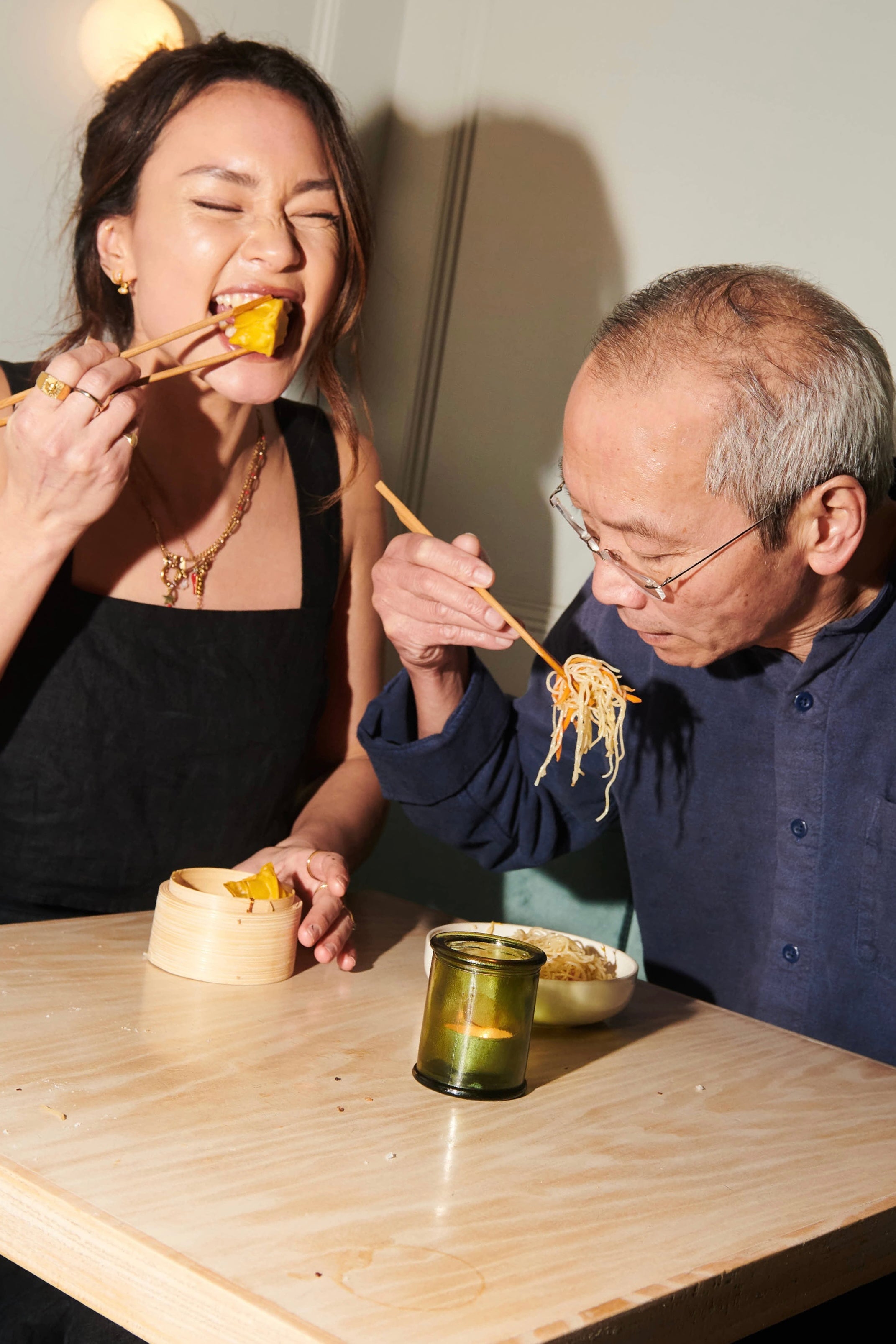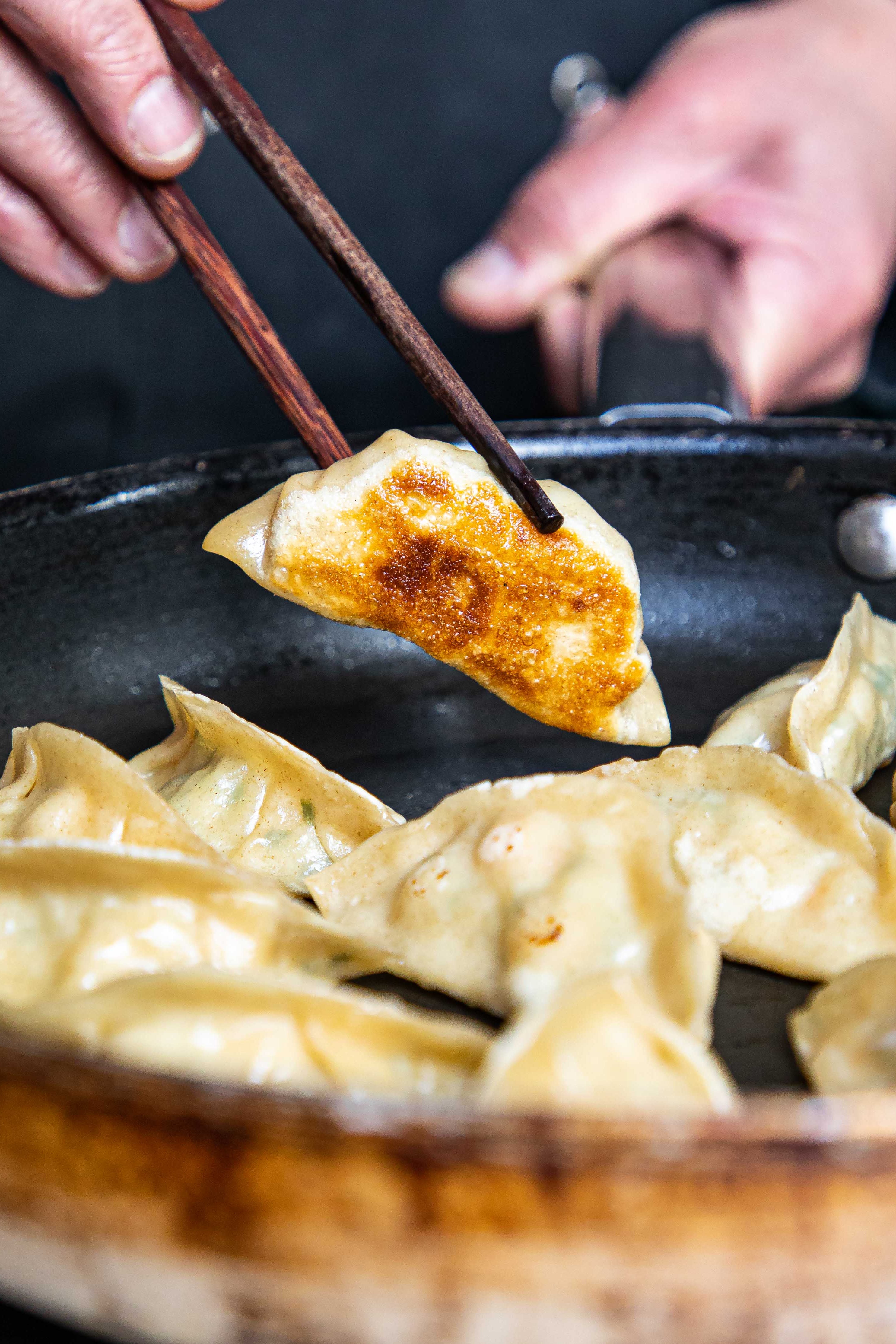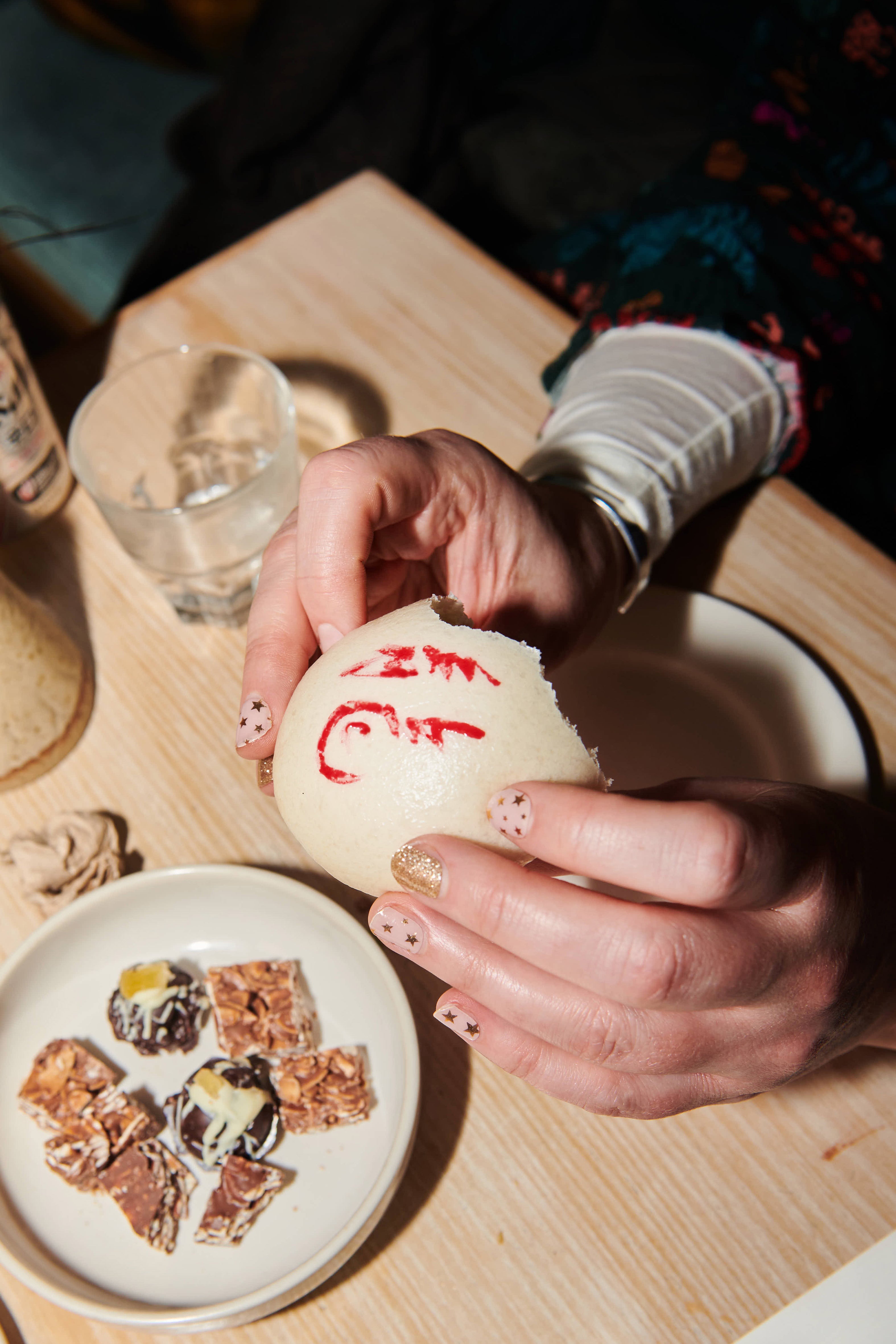The vintage fire engine pulls into Brockley Market at dawn, steam curling from its windows before a single customer has arrived. Inside is Chubby Dumpling, the father-and-daughter food truck run by Joe and Chantel Yeung, where coriander is picked, noodles fried and bamboo baskets stacked with dumplings ready to be steamed.
For Chantel, mornings start long before then. “Now that I have a baby, my day starts several hours before the market even opens,” she says. “I wake up at the crack of dawn to make sure all the dumplings, noodles, sauces are ready to go, then scramble to get my baby fed – before hustling to the market.”
The rhythm of the market is as much about people as it is about prep. There’s camaraderie between traders as they get set up, a kind of quiet joy before the first rush of customers. “I love the early morning vibe with the fellow traders before anyone else arrives – we’ve all got to know each other so well and everyone’s happy to help out,” says Chantel.
It’s a far cry from the world her dad, Joe, first entered when he moved to the UK. Born and raised in Hong Kong, food was always at the centre of his life. “We didn’t have much money growing up, and I’m one of five kids – but my mum would always rustle up a meal out of whatever she could find in the markets. The street food was cheap and I have the fondest memories of going to the street hawkers with my sisters and getting wontons or squid balls.”
That early immersion inspired his dream: to open a restaurant serving real Cantonese food, and to make it accessible to diners in England. When he first arrived, the dream felt impossibly far off. “I worked three jobs at the same time and eventually saved up enough to open my own restaurant,” he says. It was a small space, but he ran it for 31 years. Fresh lobsters, crabs, scallops and mussels came through the kitchen, testament to his belief in freshness above all.
After three decades, he retired, but couldn’t quite put food down. “I’m a restless soul,” he admits. Chantel spotted an opportunity. She “told me that I’m always making dumplings anyway, why not start a street food business together? I loved the idea – it felt like a full circle moment,” Joe says.
For Chantel, growing up in the restaurant meant food was always close at hand. “One of my earliest memories is being in dad’s restaurant and getting told off by one of the chefs for taking a prawn cracker from the kitchen,” she recalls. The lessons went deeper than discipline. She remembers the patience he showed with ingredients: hours wrenching open scallops, often cutting his hands, before steaming one immediately to share with his children. “Delicious,” she says simply.
Home life was much the same. “Dad would often bring food home from the restaurant – we’d often have live crabs moving about in the fridge. I didn’t realise this was weird until my friends would come round and be freaked out!”
It was dumplings, though, that formed the through-line. Joe would make them from whatever was to hand, creating steamy parcels bursting with flavour. They became Chantel’s favourite thing, so much so that her dad began calling her his “chubby dumpling.” The nickname stuck – and when it came time to name the food truck, there was only ever one choice.

The next challenge was where to cook. They looked at different vehicles but landed on a vintage German fire engine almost by accident. “We wanted something interesting and not huge – a bit of a happy accident really,” says Chantel. It’s now become their signature, instantly recognisable at Brockley on Saturdays and Victoria Park on Sundays.
Inside, the setup is as much about family as it is about food. “Our whole family is involved in some way, whether they like it or not,” Chantel says with a laugh. Her mum makes the chilli sauce, her brother offers business advice and her sister has worked in the van. Family meals often turn into recipe testing. “We make everyone try the same dumpling 10 times over with a very slight variation to each one. No one’s allowed to dip it in chilli because they need to taste it properly!”
Working together brings its own rewards. “The best part is spending time together,” says Chantel. “Growing up with a dad in hospitality means he was working around the clock – including weekends and evenings. So it’s really special to have this opportunity at this point in life.” But it also has its challenges. “My dad dreams of dumplings, he spends days obsessing over a recipe… which is amazing, but sometimes I just want to get on with it!”
The food itself reflects both of their personalities. “Dad was – and still is – a purist,” says Chantel. “When we started the business, he didn’t understand why I wanted a vegan dumpling on the menu because he’d never had vegan dumplings before.” She, by contrast, is keen to experiment. “I’m a mix of cultures – my mum’s English – and that’s reflected in my taste for food. I think it’s important to try new things.”
The result is a balance between the traditional and the new. Some flavours have proved perennial favourites, like the prawn dumplings with bamboo shoot and chives. “These are always a crowd pleaser,” says Chantel. “Simple, fresh and bursting with flavour.”
They’re happy to share tips, too. “Making dumplings takes patience and practice, but it’s a fun activity to do with the family,” says Joe. His method is precise: rolling each wrapper individually so the edges are thin but the middle slightly thicker, which stops them from being too doughy. Uniformity matters – if one dumpling is larger than another, they won’t cook at the same rate. Above all, make sure the edges are properly sealed. “Pinch the edges to keep the filling in,” he advises.
The best part is spending time together. Growing up with a dad in hospitality means he was working around the clock – including weekends and evenings. So it’s really special to have this opportunity at this point in life
Choosing a truck over a restaurant was as much philosophy as practicality. “I ran a restaurant for over 30 years and loved it,” says Joe. “But I also believe that eating good food shouldn’t be exclusive to people with lots of money. It was Chantel’s suggestion to do a food truck, she wanted as many people as possible to eat our dumplings and thought it was a way to take the dumplings to them, rather than them come to us.”
Street food has also introduced them to new audiences. “We’ve met so many people and introduced some people to dumplings for the first time – it’s been great,” Joe says. The contrast with restaurant life is striking. “In a restaurant, I knew all the regulars, would sit and have a drink with them, they came for 30 years and I watched their kids grow up,” he says. By comparison, “in street food there’s a lot of unpredictability, from weather (especially in England!) to queues and set up – but it’s also freeing and less formal. It’s all an adventure!”
Economically, the move makes sense, though not without difficulty. “Street food has lower overheads and more flexibility than restaurants, which can be a help when times are uncertain,” says Joe. “But I’ve seen a lot of traders close their businesses as costs rise recently; there’s a cap on what customers are willing to pay for street food.”
Part of Joe’s drive is still to reshape perceptions of Chinese food in the UK. “When I first came to England, most people thought of Chinese food as greasy takeaways serving chow mein and egg fried rice. Some of the foods people were eating I didn’t even recognise as Chinese – deep fried sweet and sour balls?!” he says.
His restaurant was designed to show a different side, one rooted in freshness and delicacy. “I would take out live lobsters to the tables for customers to see – because it’s very important to eat seafood fresh, it tastes different.” Chubby Dumpling continues that mission, showing British diners the variety and refinement in Cantonese cooking. “Nowadays, people in London are more aware of different Chinese cuisines and I think that’s great – we are all learning about different cultures through food.”
Back at the markets, the fire engine is once again steaming, queues forming at the window. Inside, Chantel balances cooking with family life, while Joe obsesses over getting each dumpling just right. It’s a business that is both deeply personal and proudly public: a family nickname turned into a brand, a restaurant career reborn on the streets.
And if you’re lucky enough to get one of their prawn dumplings fresh from the steamer, you’ll taste the philosophy that’s carried them this far – food that’s simple, fresh and shared.
Prawn and chive dumplings

“This recipe makes 15-20 dumplings, but it’s easy to scale up or down. You can use shop-bought wrappers if you prefer, but making your own is super easy and gives a more bouncy, satisfying texture and bite!”
Makes: 15-20 dumplings
Ingredients:
For the filling:
180g raw prawns, deveined and diced
1 small shallot, chopped
15g chives (or a small bunch), finely chopped
6g cornflour
Pinch of sugar
Pinch of salt
Pinch of white pepper
3g fish stock powder
30g bamboo shoots, chopped
20g vegetable oil
½ tsp of sesame seed oil
For the wrappers:
200g plain flour
80g tepid water
Method:
1. Make the dough by mixing the flour and water and kneading it; it might feel quite stiff and not completely smooth at first - that’s normal. Roll into a ball, place in a bowl, and cover; leave to rest at room temperature for 10-15 minutes. After resting, knead it and rest it again. Repeat this three times and it should be smooth and pliable ready to use.
2. Meanwhile, add all the other ingredients together except the vegetable oil and the sesame oil. Mix well to coat the prawns, then add in the oils and mix again.
3. Make the wrappers: if making a larger batch, you may want to divide the dough into halves or quarters at a time, leaving the remaining dough pieces covered so they don’t dry out. You can either use a pasta roller to make a sheet and then cut circles, or roll them individually. Following the traditional method, you mould the dough into a sausage shape, then cut off small pieces. The piece of dough for each wrapper should weigh about 12g.
4. Take one piece of cut dough, press it down to flatten slightly, then using a lightly floured rolling pin on a floured surface, roll the dough out into a circle, turning the dough around each roll to keep it even. They should be about 1mm thick and 8cm across.
5. Hold a wrapper in your hand and add about a teaspoon of filling to the centre of the wrapper, fold the dough in half and pinch at the top. Pleat the edges, folding in to the centre to seal it shut, and use the palm of your hand to flatten the bottom so it sits up.
6. Place the dumplings in a bamboo steamer (with a silicon mat/greaseproof paper under to avoid sticking). Steam for 9 minutes, then fry to add a little crisp. Serve straight away, these are great with a sprinkle of sesame seeds, spring onions and chilli oil for dipping!
Prawn toast balls

“Prawn toast is always delicious, but I often find there’s not enough prawn to toast ratio and there can be a bit of a soggy middle bit where the bread meets the prawn. So we made these prawn toast balls, to ensure you get a really good bite of prawn with a proper crunch on the toast. The prawn should be bouncy and light but firm. They make a great appetiser; an all-round crowd pleaser!”
Makes: about 20
Ingredients:
400g raw prawns
Pinch of white pepper
3g salt
10g cornflour
2 tsp sesame oil
White bread (or bread of your choice, a brioche also works well for a sweeter touch)
Vegetable oil (for frying)
Sesame seeds
Japanese mayonnaise (also known as Kewpie Mayo)
Method:
1. Pat the prawns dry with a piece of kitchen paper and place on a chopping board. Use two large knives (one in each hand), chop the prawns like you’re playing the drums with knives. Keep chopping, then scoop up the mix with the knives and pile it into the middle, chop again and continue this until a smooth paste forms on the board.
2. Put the prawn mince into a large bowl and add the white pepper, salt, cornflour and sesame oil. Mix together, then you want to use your hand to scoop up all the mixture and throw it back into the bowl as hard as you can. Repeat this about 10 times to make the mix light and bouncy.
3. Make the toast: use a small circular cutter to make 4cm disks from your bread and set aside. Heat up a pan of vegetable oil (you can use a small, high-sided pan). Once the oil is hot, deep fry the bread disks (you may need to do batches depending on how big your pan is). Once they’ve turned golden brown, remove from the oil with a slotted spoon and place on kitchen paper to soak up the excess oil. Set aside.
4. Back to the prawn mix. Pour your sesame seeds into a small bowl. Take two teaspoons (one in each hand), dip them into water to prevent the mix from sticking to the spoons, then scoop up a portion of the prawn mix, passing the ball back and forth from the spoons, scooping it off each time to form a ball. You want it to be about 4cm in diameter and formed into a round ball. Drop it into the bowl of sesame seeds and gently roll it around to coat the outside in seeds, then set aside on a plate. Repeat until you’ve used all the mix and your balls are ready to fry.
5. Deep fry the balls (again, you may need to do this in batches depending on your pan). They will take about 2-3 minutes to cook through and will float to the surface of the oil. Scoop out and place on kitchen paper.
6. To form them, just take a piece of toast, squeeze a small dollop of Japanese mayo into the middle and stick the prawn toast ball to it. Repeat to use them all and serve!
Dumpling dipping sauce
Finely dice two red chillies. Heat a glug of vegetable oil in a pan, then turn down the heat and add the chillies, don’t let them burn. Sauté the chillies until softened, then pour them into a bowl and add 4 tablespoons of light soy sauce and mix together. You can add more soy if you don’t want it too spicy.
Coconut custard bao

“Steamed custard buns are a classic dim sum, but they’re also a great thing to have in your freezer and re-steam for a quick dessert when you fancy it! Dad makes them with coconut for added depth of flavour and they’re delicious! Soft, pillowy, filled with a creamy coconut custard filling. These are best made with bao flour. If you can’t get hold of it, you can use plain flour, but it won’t be as fluffy or light, so it’s worth paying the Chinese supermarket a visit to get the bao flour.”
Makes: 10
Ingredients:
For the filling:
1 egg
75g sugar
25g melted butter
60g milk
20g custard powder
20g desiccated coconut
For the dough:
200g bao flour
85g milk
The white of one egg
4g easy bake yeast
5g baking powder
50g sugar
Method:
1. Beat the eggs and sugar together, either in a mixer or by hand.
2. Put the milk and butter in a metal bowl and place over a pan of boiling water, turn to a low heat and stir until the butter is melted. Remove from the heat and cool slightly. Once cooled a little, whisk in the custard powder, adding it slowly and whisking as you pour.
3. Add the egg mixture and stir thoroughly. Pour all the mixture through a sieve into another bowl, then pour in the desiccated coconut and mix well. Pour the mixture into a shallow dish and steam the whole dish for 9 minutes until the mixture is set. Put aside to cool.
4. To make the dough, put all the ingredients in a bowl and mix together. Once combined, take it out and knead for about 15 to 20 minutes until completely smooth. It shouldn’t be sticking to your hands but just a smooth ball.
5. Place the dough in a bowl, cover with cling film and leave in a warm place to proof. After 20 minutes of resting, tip the dough out and knead again for another five minutes. Cover and leave again for another 20 minutes. Once ready, the dough should be about 2-3 times its original size. Cut the dough into 10 portions and gently shape each piece into a ball.
6. Divide the custard mix into 10 pieces and roll each piece into a ball. Leave the balls on a plate, covered with a teatowel to prevent them from drying out.
7. Using the palm of your hand, squash the ball to form a disk, then place a portion of the filling in the middle. Draw the edges into the middle and pleat, pinching firmly to seal. Place it pleat side down into the steamer (make sure there are cut pieces of parchment paper under each one to avoid it sticking). Repeat until all buns are assembled. Place the steamer with the buns over a pan of warm water (not boiling) and leave to proof for another 10 minutes. Then turn the heat on for the pan and turn to medium. Steam over simmering water for 10 minutes. Once done, leave to rest for another two or three minutes after cooking.







